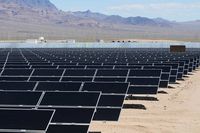
Back in the early 1880s J.P. Morgan invited Thomas Edison to put a DC power generator into his New York mansion, and while the lights worked it was a disaster. Westinghouse's backing of Tesla's A/C current was a godsend to the bankers. Karen Wood is fighting wind power in her San Francisco neighborhood for the same reason Morgan backed Westinghouse.
But renewable energy doesn't have to mean ugly. If someone stuck a 35 foot tower behind your house you'd be upset too. And you'd be inclined then to support out-of-sight solutions for your power needs.
There's a problem with out of sight solutions, however. Power loss. No matter how high you step up the voltage, aluminum is not a perfect conductor. Over the course of hundreds of miles you can lose half the power in a grid just moving power around. Solutions are starting to appear, in the form of superconductors that can be buried underground, and there will always be a need for load balancing using high voltage cables.
But it's still going to be more efficient to generate most of our power locally, if we can, because that makes for a more robust grid. A system that depends on giant remote power stations can be wrecked by terrorists quite easily. There are serious points of failure there. A more robust grid is a more secure grid.

In the end the conflict between big and little solar should work itself out. Whoever can generate the most power at the lowest price should win.
Unfortunately power generation is still considered a long term capital investment, not a short term purchase. A lot of sins can be hidden in a 30-year note — ask your homebuilder. Besides, in the short term no form of renewable power can create electricity with the efficiency of burning stuff. The result is a political battle, with 100 years of habit competing against a host of small entrepreneuers for the government subsidies needed to do business.
The solution, I think, is a new way of looking at subsidies. Price differentials.
Instead of basing subsidies on costs, base them on the difference in price between current technology and what's being offered. Set a central location for the collection of power in an urban area, let that cost be your baseline, and calculate real rates for every proposed project, large and small, which wants to connect to the grid. Set your subsidy budget annually, and only approve projects that can meet the price test best until that year's subsidy budget is exhausted.
This does not exclude big solar from the market. Far from it. The 48 megawatt Copper Mountain project (above), the largest solar project yet permitted, is just 40 miles from Las Vegas.
For a homeowner or business who wants to sell power through net metering, the market price becomes the price they get for their excess power. They can calculate their own costs and decide for themselves whether a project is worth their money. But any large off-grid project should also go through this calculation. Justify the ratepayer's love, don't just think you can throw any boondoggle at us and expect us to pay by calling yourself green. And add the cost of transmission to that calculation.
My guess is a lot of big solar won't get built on that basis. I'm guessing a lot of big wind projects will either disappear, or look for customers closer to their supply, if transmission costs have to be calculated, if they have to compete directly with small solar for subsidies and capital. Some will, but a lot won't.
That's a good thing.










Dana proposes to hide the inefficiencies of solar power by stealing money from hardworking people so that the government can
– subsidize inefficient energy
– tax efficient energy.
This proves two things:
1. Dana acknowledges that solar energy is inefficient.
2. Dana is a liberal.
Dana proposes to hide the inefficiencies of solar power by stealing money from hardworking people so that the government can
– subsidize inefficient energy
– tax efficient energy.
This proves two things:
1. Dana acknowledges that solar energy is inefficient.
2. Dana is a liberal.
online Casino
Dana Blankenhorn: Big Solar vs. Little Solar